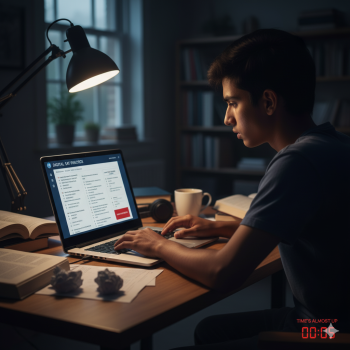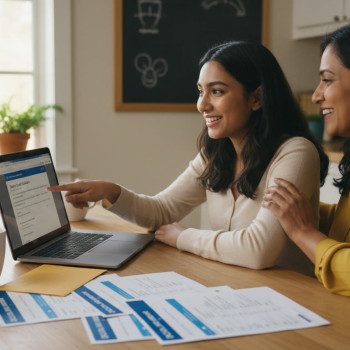Why Digital Literacy Now Shapes Your SAT Performance
If you grew up tapping, swiping, and scrolling, you might think digital tests should be second nature. But the Digital SAT is more than just a screen-based version of a paper test—it’s a different rhythm, a new toolkit, and a small suite of digital skills that can meaningfully change your score. This isn’t about being a “techie”; it’s about being fluent in the environment where the test now lives. In this post we’ll unpack why digital literacy matters, give practical, evidence-backed strategies you can apply right away, and show how smart, personalized support (like Sparkl’s 1-on-1 tutoring and AI-driven insights) can accelerate progress without adding stress.
What do we mean by “digital literacy” for the SAT?
Digital literacy for the Digital SAT means more than knowing how to turn on a device. It’s a set of comfort-level skills and habits that let you focus on reasoning, not on navigation. Key elements include:
- Familiarity with the Bluebook testing app and its universal tools (highlighter, notes, line reader, calculator, question menu).
- Speed and comfort reading on-screen—especially with longer passages or dense graphs.
- Effective annotation and selective highlighting without wasting time.
- Smart use of the built-in calculator and scratch tools instead of defaulting to inefficient mental math.
- Device readiness—knowing how to handle zoom, color contrast, and small adjustments quickly.
Each of these sounds small on its own. Together they shave minutes off mental clutter, reduce mistakes born of misclicks or misplaced highlights, and let your brain apply energy where it matters: understanding the question.
Why these skills matter now (and why they weren’t as crucial before)
When the SAT was paper-based, a lot of your toolkit was physical: pencils, margin notes, and a ruler to line up equations. The shift to digital changes what “muscle memory” the test rewards. Here’s how:
- Time allocation is different. Digital tests often give more time per question on average, but the pacing is adaptive—comfort with navigation helps you use that time wisely.
- New universal tools change strategy. Features like expand passage, option eliminator, and a built-in calculator change how you approach specific question types. Not using them effectively is like bringing a knife to a gunfight.
- Accessibility and accommodations are integrated into the platform. If you know how to configure and practice with them ahead of time, you gain consistency and calm on test day.
- Screen reading is cognitively different than paper reading. Our eyes and attention work differently on screens—line reader tools and focus strategies help mitigate fatigue and misreads.
Real-world examples: small digital habits with big score impact
Let’s look at tangible examples where digital literacy can directly affect performance:
- Efficient passage expansion: On long reading passages, expanding a paragraph so the line reader tracks only a few lines can prevent rereading and reduce eye strain—saving precious mental energy for comprehension.
- Annotation vs. over-highlighting: Highlighting mechanically can cost time and attention. Experienced test-takers use quick tags—like H for hypothesis, E for evidence—so their highlights function as micro-signposts rather than noise.
- Calculator proficiency: The built-in calculator handles many functions, but knowing when to trust it (complex arithmetic) and when to skip it (simple algebra) prevents wasted seconds and careless keystroke errors.
- Mark for review and strategic skipping: The question menu and mark-for-review feature let you jump between blocks and return strategically. Students who practice this navigate the adaptive structure more confidently.
How much of a difference can digital literacy make?
It’s tempting to ask, “How many points could mastering these skills add?” While each student’s gains vary, think about the difference between stumbling over navigation for 10–15 seconds per question and moving smoothly. Across a section with 50 questions, shaving off hesitation and avoiding careless errors can translate into several more correct answers—enough to move your score band and make a real difference in college admissions and scholarships.
Concrete habits to build: a 6-week digital literacy plan
Below is a practical plan you can follow. Work through it deliberately, track how you feel, and adjust the pace to your schedule.
Week-by-week overview
| Week | Focus | Daily activity (20–40 min) | Goal |
|---|---|---|---|
| 1 | Device & App Familiarity | Install Bluebook; explore tools; take a short practice section. | Remove technical anxiety; know where tools live. |
| 2 | Reading on Screen | Practice 2 reading passages using line reader & expand passage. | Improve on-screen reading stamina and comprehension. |
| 3 | Annotation & Highlighting | Practice targeted marking. Time yourself and refine shorthand. | Faster, more useful notes that actually help. |
| 4 | Calculator & Math Tools | Practice questions using built-in calculator; learn shortcuts. | Efficient numeric handling and error reduction. |
| 5 | Pacing & Section Strategy | Full timed section; practice mark-for-review & jump strategy. | Confident pacing and stronger time allocation. |
| 6 | Simulated Test & Reflection | Full digital practice test in Bluebook; review mistakes and habits. | Integrate skills; identify remaining weak spots. |
Do this plan alongside content review. The literacy plan doesn’t replace math practice or grammar drills—it amplifies their impact by letting you apply knowledge more efficiently on test day.
Study session blueprint: how to practice a single reading passage
One efficient practice routine for a single passage (20–30 minutes):
- Skim the passage for structure (2 minutes). Note paragraph names or functions: intro, claim, evidence, counterargument.
- Use the expand-passage tool to focus on each paragraph while reading with the line reader (6–8 minutes).
- Highlight only two things: the central claim and one key piece of evidence per paragraph (2 minutes).
- Answer questions, using option eliminator for process-of-elimination (6–8 minutes).
- Review incorrect answers and annotate the passage with a short note on why you missed them (2–4 minutes).
Quick tech checklist for test day
- Bluebook installed and updated on your device; practice test completed at least twice on the same device.
- Charged battery and charger packed; confirm device specs meet test requirements.
- Practice with any accessibility features or accommodations you’ll use.
- Familiarize with the testing environment—where you’ll place scratch paper, how you’ll use headphones, etc.
How to combine digital literacy with content study
Digital literacy and content knowledge are complementary. Think of literacy as the lubricant that prevents friction between what you know and how you show it. Pair each study block with a short digital skill drill:
- After a math topic (e.g., quadratics), do 10 digital math items and practice switching between the calculator and mental math.
- After a grammar mini-lesson, practice questions focusing on evidence and sentence structure using built-in tools to mark answer choices you eliminate.
- After a reading comprehension exercise, re-run the passage in Bluebook’s expand mode to see if digital reading changes your comprehension speed or accuracy.
How personalized tutoring accelerates digital literacy (and why it helps)
Not everyone benefits equally from one-size-fits-all advice. That’s where personalized tutoring shines. A tutor who understands both SAT content and the mechanics of digital testing can:
- Diagnose where digital friction occurs—are you losing time because of navigation, highlighting, or device lag?
- Create a tailored plan that weaves digital-skill drills into content study so you don’t waste time learning tools in isolation.
- Offer real-time feedback during simulated digital tests—pointing out small habits that cost time or induce errors.
For students who want one-on-one guidance, Sparkl’s personalized tutoring blends expert tutors with AI-driven insights to quickly identify patterns—such as consistent misreads on a certain passage type or repeated calculator errors—and build a plan to fix them. When the tutoring is targeted this way, you see faster improvement and less frustration than with generic practice alone.
Common pitfalls students face and how to avoid them
Here are mistakes I see repeatedly and simple fixes you can try immediately:
- Over-highlighting: Fix: Limit yourself to two highlights per paragraph—central claim and strongest evidence.
- Relying on mental math for everything: Fix: Use the built-in calculator for multi-step arithmetic to reduce careless errors; practice keyboard comfort if using a Windows or Mac numeric interface.
- Forgetting to mark questions for review: Fix: Use the question menu intentionally—mark quick guesses to return later rather than re-reading whole passages.
- Device panic: Fix: Run two mock tests on the same device and location where you’ll test so nothing is unfamiliar on the day.
Sample diagnostic checklist: where to invest your time
Run this short self-audit after a practice test to find high-impact improvements.
| Symptom | Likely Cause | Action |
|---|---|---|
| Repeated careless errors on multi-step math | Poor calculator strategy or rushed entry | Practice calculator use, write small interim results on scratch paper. |
| Slow reading speed on-screen | Screen fatigue, lack of line-reader use | Practice expand passage + line reader; build short daily reading sessions. |
| Lost time toggling between questions | Unfamiliar with question menu and mark-for-review | Simulate section jumps in practice, use question menu intentionally. |
| Feeling anxious about the device | Insufficient device practice | Do full-length practice tests on the same device; pack a checklist for test day. |
Putting it all together: a sample 90-minute practice block
Structure matters. Here’s an efficient window to build both content and digital fluency:
- 0–10 min: Warm-up—quick mental math and a 2-paragraph reading excerpt using the line reader.
- 10–40 min: Focused content session—work through a targeted set of math or grammar problems.
- 40–60 min: Digital skills drill—practice using the calculator, mark-for-review, and highlight shorthand on 10 practice items.
- 60–85 min: Timed mini-section in Bluebook (simulate pressure).
- 85–90 min: Quick review—note two things you did well and two habits to fix next session.
What to expect on test day (digital logistics that affect performance)
On the day, your environment and the digital setup can be as influential as your content knowledge. Expect:
- A proctored environment with the Bluebook testing app or school-managed testing portal.
- Universal tools available to everyone—zoom, highlight, line reader. Know how to toggle them quickly.
- Access to a built-in calculator for all math questions.
- Clear instructions on device use and what to bring; practice these ahead of time.
Practice with the exact setup you’ll use. Bring the quiet confidence of routine instead of the panic of first-time surprises.
Final thoughts: digital literacy as a skill for college and beyond
Learning to move smoothly through the Digital SAT is not just about one test. You’re building a lifelong habit: how to read densely on-screen, how to highlight with purpose, how to use digital tools to scaffold reasoning. Those are the same skills that matter in college classes, online assessments, and many workplaces.
If you’re looking for a boost and want coaching tailored to your habits (not a generic checklist), consider personalized tutoring that blends human expertise with data-driven insights. Tutors can spot the small habits—inefficient highlighting, poor calculator entry rhythm, or suboptimal navigation—that cost time and confidence. Sparkl’s approach to 1-on-1 guidance, tailored study plans, and AI-informed feedback is an example of how combining human coaching and smart analytics can accelerate improvement without overwhelming you.
Next steps: an action checklist
- Install and explore the Bluebook app on your device. Take the app tour and try a practice section.
- Run the 6-week digital literacy plan alongside content review.
- Do one full-length practice test on your testing device every two weeks and review performance not just by score but by digital mistakes (navigation, timing, annotation).
- Consider short-term tutoring focused on digital test strategies if you’re consistently losing points to navigational errors—one-on-one coaching can identify and fix these quickly.
Closing: confidence is the final tool
At the end of the day, the Digital SAT rewards calm, clarity, and efficient habits. Digital literacy gives you tools to stay calm and keep your attention on what matters—the reasoning and problem-solving that reveal your thinking. Practice consistently, focus on small habits that compound, and use personalized support if you want faster, less stressful progress. You already have the intelligence; now give it the digital home it deserves and watch your performance follow.
Good luck—and remember: the technology is there to help you show what you know. Master the tech, and the SAT becomes a cleaner, fairer measure of your skills.















No Comments
Leave a comment Cancel